当前位置:网站首页>GraphQL背后处理及执行过程是什么
GraphQL背后处理及执行过程是什么
2022-08-04 00:52:00 【亿速云】
GraphQL背后处理及执行过程是什么
这篇文章主要讲解了“GraphQL背后处理及执行过程是什么”,文中的讲解内容简单清晰,易于学习与理解,下面请大家跟着小编的思路慢慢深入,一起来研究和学习“GraphQL背后处理及执行过程是什么”吧!
Hello World
package com.graphqljava.tutorial.bookdetails;import graphql.ExecutionResult;import graphql.GraphQL;import graphql.schema.GraphQLSchema;import graphql.schema.StaticDataFetcher;import graphql.schema.idl.RuntimeWiring;import graphql.schema.idl.SchemaGenerator;import graphql.schema.idl.SchemaParser;import graphql.schema.idl.TypeDefinitionRegistry;public class HelloWorld { public static void main(String[] args) { // 从最简单的schema字符串开始,省去对graphqls文件的读取 String schema = "type Query{hello: String}"; // 用于获得graphql schema定义,并解析放入TypeDefinitionRegistry中,以便放置在SchemaGenerator中使用 SchemaParser schemaParser = new SchemaParser(); // 解析schema定义字符串,并创建包含一组类型定义的TypeDefinitionRegistry TypeDefinitionRegistry typeDefinitionRegistry = schemaParser.parse(schema); // runtime wiring 是data fetchers、type resolves和定制标量的规范,这些都需要连接到GraphQLSchema中 RuntimeWiring runtimeWiring = RuntimeWiring.newRuntimeWiring() // 添加一个类型连接 .type("Query", builder -> builder.dataFetcher("hello", new StaticDataFetcher("world"))) .build(); //schemaGenerator对象可以使用typeDefinitionRegistry、runtimeWiring生成工作运行时schema SchemaGenerator schemaGenerator = new SchemaGenerator(); //graphQLSchema代表graphql引擎的组合类型系统。 GraphQLSchema graphQLSchema = schemaGenerator.makeExecutableSchema(typeDefinitionRegistry, runtimeWiring); //构建GraphQL用于执行查询 GraphQL build = GraphQL.newGraphQL(graphQLSchema).build(); //执行并获得结果 ExecutionResult executionResult = build.execute("{hello}"); System.out.println(executionResult.getData().toString()); }}从上面的代码注释可以看到GraphQL大致执行的过程:
根据给定的schema内容使用SchemaParser进行解析获得schema定义TypeDefinitionRegistry。
拿到了schema定义之后还需要定义RuntimeWiring用于定义不同类型的type resolves和对应的数据提取器data fetchers。
使用GraphQLSchema把TypeDefinitionRegistry和RuntimeWiring组合在一起便于以后的使用。
使用GraphQLSchema构建出GraphQL用于后面的QL执行。
传入QL使用GraphQL执行并获得结果ExecutionResult。
从外层使用代码可以得出核心处理类为:SchemaParser、TypeDefinitionRegistry、RuntimeWiring、GraphQLSchema、GraphQL。
下面我们分配看看核心类是怎么处理的。
SchemaParser
解析schema字符串定义并生成TypeDefinitionRegistry。
public TypeDefinitionRegistry parse(String schemaInput) throws SchemaProblem { try { Parser parser = new Parser(); Document document = parser.parseDocument(schemaInput); return buildRegistry(document); } catch (ParseCancellationException e) { throw handleParseException(e); }}使用Document构建TypeDefinitionRegistry
public TypeDefinitionRegistry buildRegistry(Document document) { List<GraphQLError> errors = new ArrayList<>(); TypeDefinitionRegistry typeRegistry = new TypeDefinitionRegistry(); List<Definition> definitions = document.getDefinitions(); for (Definition definition : definitions) { if (definition instanceof SDLDefinition) { typeRegistry.add((SDLDefinition) definition).ifPresent(errors::add); } } if (errors.size() > 0) { throw new SchemaProblem(errors); } else { return typeRegistry; }}可以看的出来TypeDefinitionRegistry只是对Document的定义提取,重点还是在于Document的生成,我们可以先通过debugger来先看看Document的大致内容。
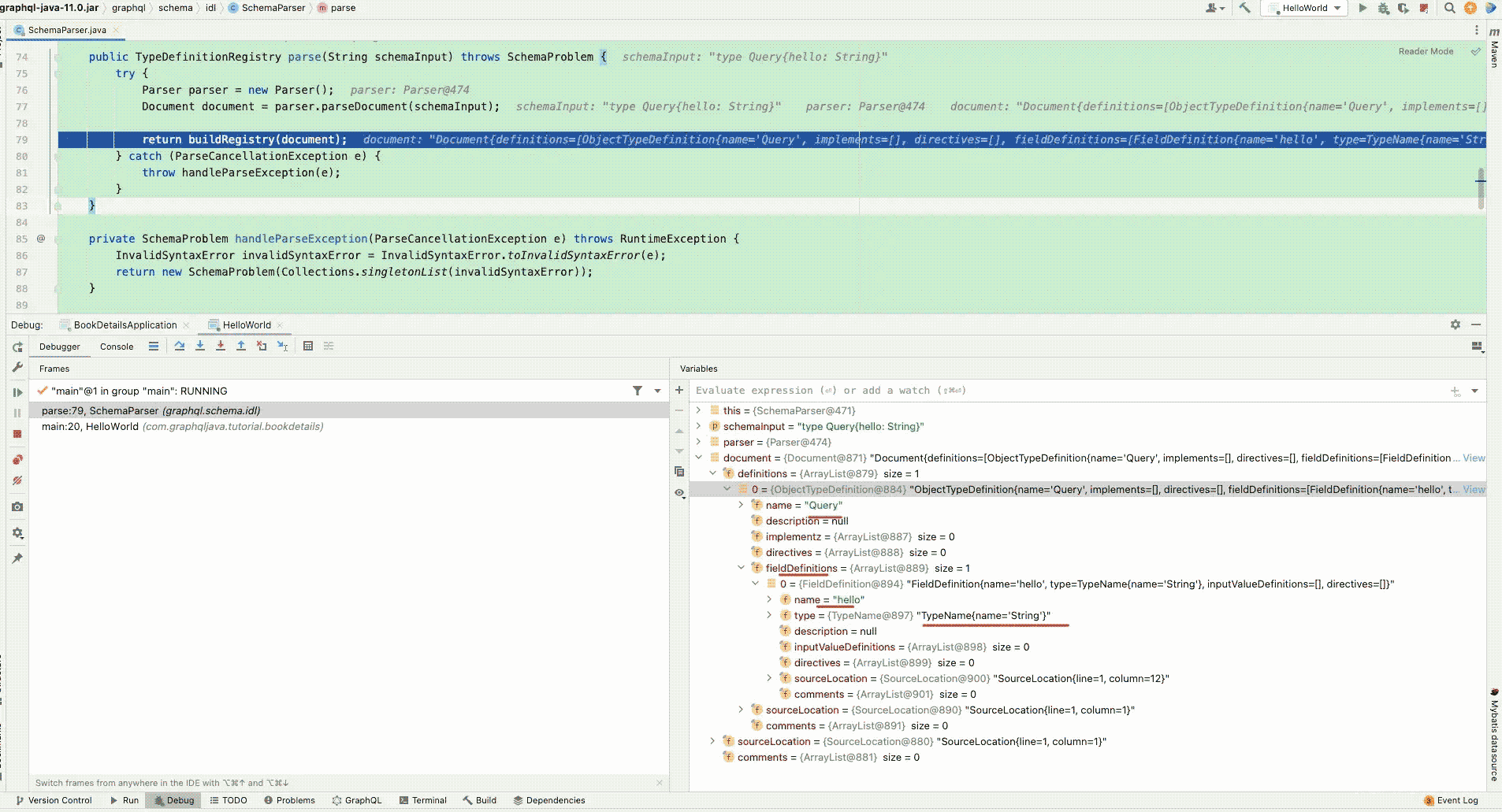
可以看到就是把schema字符串解析成了方便后续使用的Document对象,我们还是详细看看这个对象里面的属性和大概的生成过程。
Parser#parseDocument
public Document parseDocument(String input, String sourceName) { CharStream charStream; if(sourceName == null) { charStream = CharStreams.fromString(input); } else{ charStream = CharStreams.fromString(input, sourceName); } GraphqlLexer lexer = new GraphqlLexer(charStream); CommonTokenStream tokens = new CommonTokenStream(lexer); GraphqlParser parser = new GraphqlParser(tokens); parser.removeErrorListeners(); parser.getInterpreter().setPredictionMode(PredictionMode.SLL); parser.setErrorHandler(new BailErrorStrategy()); //词法分析从schema中解析出tokens(每个关键字、最后一个为EOF),documentContext包含children、start/stop字符等相当于结构。 GraphqlParser.DocumentContext documentContext = parser.document(); GraphqlAntlrToLanguage antlrToLanguage = new GraphqlAntlrToLanguage(tokens); // 生成document Document doc = antlrToLanguage.createDocument(documentContext); Token stop = documentContext.getStop(); List<Token> allTokens = tokens.getTokens(); if (stop != null && allTokens != null && !allTokens.isEmpty()) { Token last = allTokens.get(allTokens.size() - 1); // // do we have more tokens in the stream than we consumed in the parse? // if yes then its invalid. We make sure its the same channel boolean notEOF = last.getType() != Token.EOF; boolean lastGreaterThanDocument = last.getTokenIndex() > stop.getTokenIndex(); boolean sameChannel = last.getChannel() == stop.getChannel(); if (notEOF && lastGreaterThanDocument && sameChannel) { throw new ParseCancellationException("There are more tokens in the query that have not been consumed"); } } return doc;}tokens&documentContext
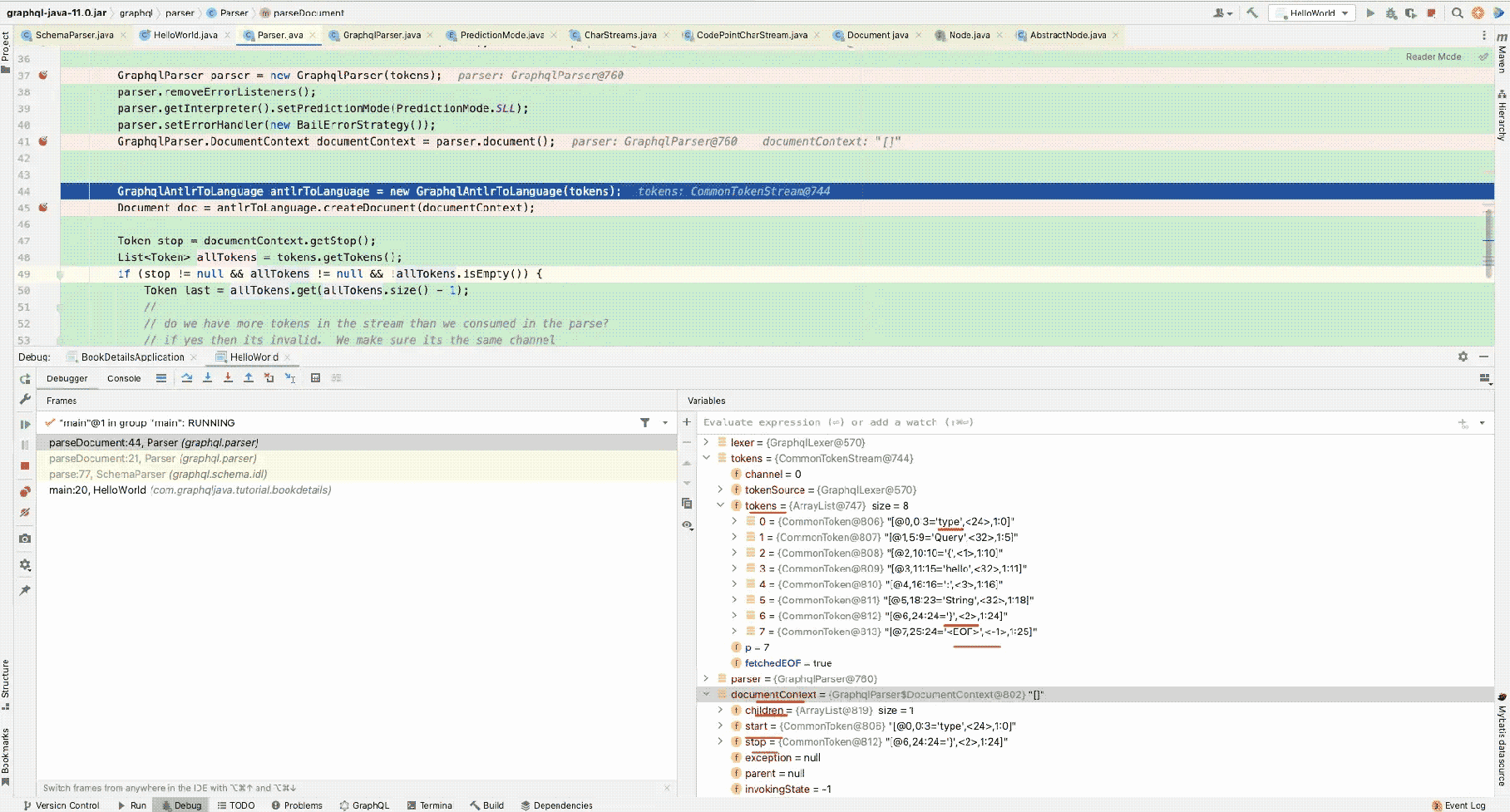
可以看到,主要是通过提取schema的关键字、识别结构最后生成Document主要内容为类型定义定义和类型定义中的字段定义。
RuntimeWiring
runtime wiring 是data fetchers、type resolves和定制标量的规范,这些都需要连接到GraphQLSchema中。
RuntimeWiring.Builder#type
这种形式允许使用lambda作为type wiring的构建器。
public Builder type(String typeName, UnaryOperator<TypeRuntimeWiring.Builder> builderFunction) { TypeRuntimeWiring.Builder builder = builderFunction.apply(TypeRuntimeWiring.newTypeWiring(typeName)); return type(builder.build());}添加type wiring。
public Builder type(TypeRuntimeWiring typeRuntimeWiring) { String typeName = typeRuntimeWiring.getTypeName(); Map<String, DataFetcher> typeDataFetchers = dataFetchers.computeIfAbsent(typeName, k -> new LinkedHashMap<>()); typeRuntimeWiring.getFieldDataFetchers().forEach(typeDataFetchers::put); defaultDataFetchers.put(typeName, typeRuntimeWiring.getDefaultDataFetcher()); TypeResolver typeResolver = typeRuntimeWiring.getTypeResolver(); if (typeResolver != null) { this.typeResolvers.put(typeName, typeResolver); } EnumValuesProvider enumValuesProvider = typeRuntimeWiring.getEnumValuesProvider(); if (enumValuesProvider != null) { this.enumValuesProviders.put(typeName, enumValuesProvider); } return this;}可以看到主要就是网RuntimeWiring里面添加了dataFetchers、defaultDataFetchers、typeResolvers、enumValuesProviders。下面分别介绍下各属性的含义:
DataFetcher:负责返回给定graphql字段数据值。graphql引擎使用datafetcher将逻辑字段解析/获取到运行时对象,该对象将作为整个graphql grapql.ExecutionResult的一部分发送回来。
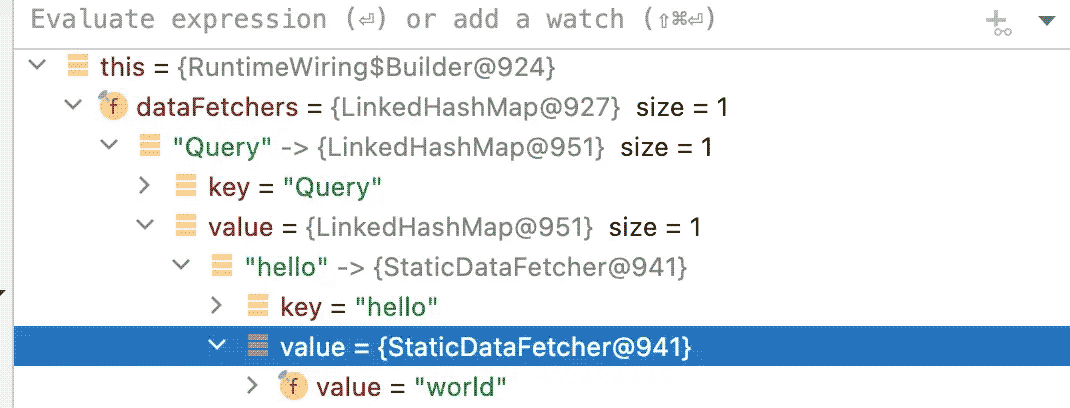
GraphQLScalarType:scalar type是graphql树类型的叶节点。该类型允许你定义新的scalar type。
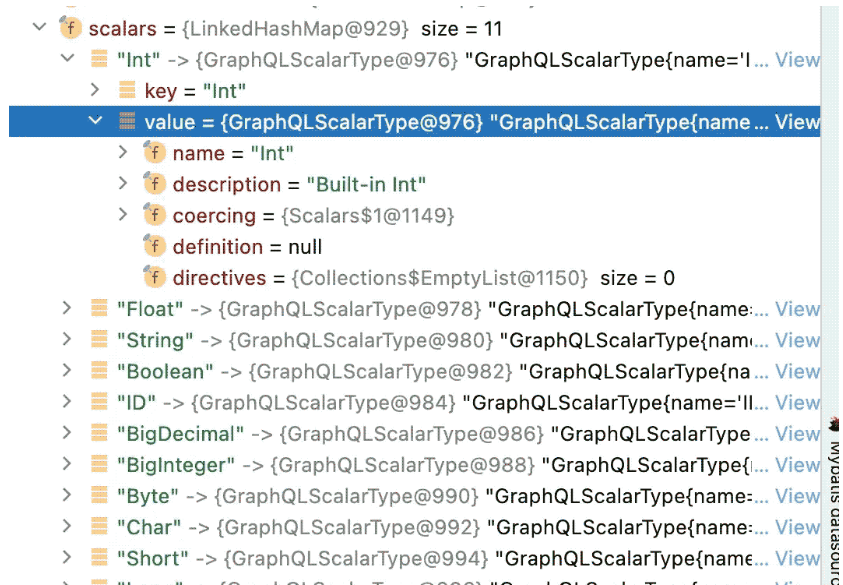
TypeResolver:这在类型解析期间被调用,以确定在运行时GraphQLInterfaceTypes和GraphQLUnionTypes应该动态使用哪些具体的GraphQLObjectType。
GraphQLInterfaceTypes:在graphql中,接口是一种抽象类型,它定义了一组字段,类型必须包含这些字段才能实现该接口。在运行时,TypeResolver用于获取一个接口对象值,并决定哪个GraphQLObjectType表示此接口类型。关于这个概念的更多细节,请参见graphql.org/learn/schem…
GraphQLUnionTypes:联合类型,相当于组合。
GraphQLObjectType:这是工作马类型,表示一个对象,它具有一个或多个字段值,这些字段可以根据对象类型等进行自身的处理,直到到达由GraphQLScalarTypes表示的类型树的叶节点。关于这个概念的更多细节,请参见graphql.org/learn/schem…
SchemaDirectiveWiring:SchemaDirectiveWiring负责基于schema定义语言(SDL)中放置在该元素上的指令增强运行时元素。它可以增强graphql运行时元素并添加新的行为,例如通过更改字段graphql.schema. datafetcher。
WiringFactory:WiringFactory允许您基于IDL定义更动态的连接TypeResolvers和DataFetchers。
EnumValuesProvider:为每个graphql Enum值提供Java运行时值。用于IDL驱动的schema创建。Enum值被认为是静态的:在创建schema时调用。在执行查询时不使用。
GraphqlFieldVisibility:这允许您控制graphql字段的可见性。默认情况下,graphql-java使每个定义的字段可见,但您可以实现此接口的实例并减少特定字段的可见性。
GraphQL
build
例子中通过传入GraphQLSchema构建GraphQL。
public GraphQL build() { assertNotNull(graphQLSchema, "graphQLSchema must be non null"); assertNotNull(queryExecutionStrategy, "queryStrategy must be non null"); assertNotNull(idProvider, "idProvider must be non null"); return new GraphQL(graphQLSchema, queryExecutionStrategy, mutationExecutionStrategy, subscriptionExecutionStrategy, idProvider, instrumentation, preparsedDocumentProvider);}除了graphQLSchema都是默认值,我们大概看看各个成员分别是用来干嘛的:
queryExecutionStrategy:异步非阻塞地运行字段的标准graphql执行策略。
mutationExecutionStrategy:异步非阻塞执行,但串行:当时只有一个字段将被解析。关于每个字段的非串行(并行)执行,请参阅AsyncExecutionStrategy。
subscriptionExecutionStrategy:通过使用reactive-streams作为订阅查询的输出结果来实现graphql订阅。
idProvider:executionid的提供者
instrumentation:提供了检测GraphQL查询执行步骤的功能。
preparsedDocumentProvider:客户端连接文档缓存和/或查询白名单的接口。
execute
下面我们还是来看看具体的执行:
public ExecutionResult execute(ExecutionInput executionInput) { try { return executeAsync(executionInput).join(); } catch (CompletionException e) { if (e.getCause() instanceof RuntimeException) { throw (RuntimeException) e.getCause(); } else { throw e; } }}用提供的输入对象执行graphql query。这将返回一个承诺(又名CompletableFuture),以提供一个ExecutionResult,这是执行所提供查询的结果。
public CompletableFuture<ExecutionResult> executeAsync(ExecutionInput executionInput) { try { log.debug("Executing request. operation name: '{}'. query: '{}'. variables '{}'", executionInput.getOperationName(), executionInput.getQuery(), executionInput.getVariables()); // 创建InstrumentationState对象,这是一个跟踪Instrumentation全生命周期的对象 InstrumentationState instrumentationState = instrumentation.createState(new InstrumentationCreateStateParameters(this.graphQLSchema, executionInput)); InstrumentationExecutionParameters inputInstrumentationParameters = new InstrumentationExecutionParameters(executionInput, this.graphQLSchema, instrumentationState); // 检测输入对象 executionInput = instrumentation.instrumentExecutionInput(executionInput, inputInstrumentationParameters); InstrumentationExecutionParameters instrumentationParameters = new InstrumentationExecutionParameters(executionInput, this.graphQLSchema, instrumentationState); // 在执行检测 chain前调用 InstrumentationContext<ExecutionResult> executionInstrumentation = instrumentation.beginExecution(instrumentationParameters); // 检测GraphQLSchema GraphQLSchema graphQLSchema = instrumentation.instrumentSchema(this.graphQLSchema, instrumentationParameters); // 对客户端传递的query进行验证并执行 CompletableFuture<ExecutionResult> executionResult = parseValidateAndExecute(executionInput, graphQLSchema, instrumentationState); // // finish up instrumentation executionResult = executionResult.whenComplete(executionInstrumentation::onCompleted); // // allow instrumentation to tweak the result executionResult = executionResult.thenCompose(result -> instrumentation.instrumentExecutionResult(result, instrumentationParameters)); return executionResult; } catch (AbortExecutionException abortException) { return CompletableFuture.completedFuture(abortException.toExecutionResult()); }}parseValidateAndExecute(executionInput, graphQLSchema, instrumentationState)进行验证并执行,验证我们就不看了直接看执行:
private CompletableFuture<ExecutionResult> execute(ExecutionInput executionInput, Document document, GraphQLSchema graphQLSchema, InstrumentationState instrumentationState) { String query = executionInput.getQuery(); String operationName = executionInput.getOperationName(); Object context = executionInput.getContext(); Execution execution = new Execution(queryStrategy, mutationStrategy, subscriptionStrategy, instrumentation); ExecutionId executionId = idProvider.provide(query, operationName, context); log.debug("Executing '{}'. operation name: '{}'. query: '{}'. variables '{}'", executionId, executionInput.getOperationName(), executionInput.getQuery(), executionInput.getVariables()); CompletableFuture<ExecutionResult> future = execution.execute(document, graphQLSchema, executionId, executionInput, instrumentationState); future = future.whenComplete((result, throwable) -> { if (throwable != null) { log.error(String.format("Execution '%s' threw exception when executing : query : '%s'. variables '%s'", executionId, executionInput.getQuery(), executionInput.getVariables()), throwable); } else { int errorCount = result.getErrors().size(); if (errorCount > 0) { log.debug("Execution '{}' completed with '{}' errors", executionId, errorCount); } else { log.debug("Execution '{}' completed with zero errors", executionId); } } }); return future;}这里打印日志为
Executing '9c81e267-c55a-4ebd-9f9c-3a2270b28103'. operation name: 'null'. query: '{hello}'. variables '{}'
还要继续往下看:
Execution#execute
public CompletableFuture<ExecutionResult> execute(Document document, GraphQLSchema graphQLSchema, ExecutionId executionId, ExecutionInput executionInput, InstrumentationState instrumentationState) { // 获得要执行的操作 NodeUtil.GetOperationResult getOperationResult = NodeUtil.getOperation(document, executionInput.getOperationName()); Map<String, FragmentDefinition> fragmentsByName = getOperationResult.fragmentsByName; OperationDefinition operationDefinition = getOperationResult.operationDefinition; ValuesResolver valuesResolver = new ValuesResolver(); // 获得输入的参数 Map<String, Object> inputVariables = executionInput.getVariables(); List<VariableDefinition> variableDefinitions = operationDefinition.getVariableDefinitions(); Map<String, Object> coercedVariables; try { coercedVariables = valuesResolver.coerceArgumentValues(graphQLSchema, variableDefinitions, inputVariables); } catch (RuntimeException rte) { if (rte instanceof GraphQLError) { return completedFuture(new ExecutionResultImpl((GraphQLError) rte)); } throw rte; } ExecutionContext executionContext = newExecutionContextBuilder() .instrumentation(instrumentation) .instrumentationState(instrumentationState) .executionId(executionId) .graphQLSchema(graphQLSchema) .queryStrategy(queryStrategy) .mutationStrategy(mutationStrategy) .subscriptionStrategy(subscriptionStrategy) .context(executionInput.getContext()) .root(executionInput.getRoot()) .fragmentsByName(fragmentsByName) .variables(coercedVariables) .document(document) .operationDefinition(operationDefinition) // 放入dataloder .dataLoaderRegistry(executionInput.getDataLoaderRegistry()) .build(); InstrumentationExecutionParameters parameters = new InstrumentationExecutionParameters( executionInput, graphQLSchema, instrumentationState ); // 获得执行上下文 executionContext = instrumentation.instrumentExecutionContext(executionContext, parameters); return executeOperation(executionContext, parameters, executionInput.getRoot(), executionContext.getOperationDefinition());}获得了执行上下文并执行,下面继续看executeOperation:
private CompletableFuture<ExecutionResult> executeOperation(ExecutionContext executionContext, InstrumentationExecutionParameters instrumentationExecutionParameters, Object root, OperationDefinition operationDefinition) { // ... ExecutionStrategyParameters parameters = newParameters() .executionStepInfo(executionStepInfo) .source(root) .fields(fields) .nonNullFieldValidator(nonNullableFieldValidator) .path(path) .build(); CompletableFuture<ExecutionResult> result; try { ExecutionStrategy executionStrategy; if (operation == OperationDefinition.Operation.MUTATION) { executionStrategy = mutationStrategy; } else if (operation == SUBSCRIPTION) { executionStrategy = subscriptionStrategy; } else { executionStrategy = queryStrategy; } log.debug("Executing '{}' query operation: '{}' using '{}' execution strategy", executionContext.getExecutionId(), operation, executionStrategy.getClass().getName()); result = executionStrategy.execute(executionContext, parameters); } catch (NonNullableFieldWasNullException e) { // ... } // ... return deferSupport(executionContext, result);}日志输出:
Executing '9c81e267-c55a-4ebd-9f9c-3a2270b28103' query operation: 'QUERY' using 'graphql.execution.AsyncExecutionStrategy' execution strategy
最终使用AsyncExecutionStrategy策略执行,继续往下看:
AsynExecutionStrategy#execute
public CompletableFuture<ExecutionResult> execute(ExecutionContext executionContext, ExecutionStrategyParameters parameters) throws NonNullableFieldWasNullException { Instrumentation instrumentation = executionContext.getInstrumentation(); InstrumentationExecutionStrategyParameters instrumentationParameters = new InstrumentationExecutionStrategyParameters(executionContext, parameters); ExecutionStrategyInstrumentationContext executionStrategyCtx = instrumentation.beginExecutionStrategy(instrumentationParameters); Map<String, List<Field>> fields = parameters.getFields(); // 字段名称 List<String> fieldNames = new ArrayList<>(fields.keySet()); List<CompletableFuture<FieldValueInfo>> futures = new ArrayList<>(); List<String> resolvedFields = new ArrayList<>(); for (String fieldName : fieldNames) { List<Field> currentField = fields.get(fieldName); ExecutionPath fieldPath = parameters.getPath().segment(mkNameForPath(currentField)); ExecutionStrategyParameters newParameters = parameters .transform(builder -> builder.field(currentField).path(fieldPath).parent(parameters)); if (isDeferred(executionContext, newParameters, currentField)) { executionStrategyCtx.onDeferredField(currentField); continue; } resolvedFields.add(fieldName); // 处理字段,这里处理的是"hello" CompletableFuture<FieldValueInfo> future = resolveFieldWithInfo(executionContext, newParameters); futures.add(future); } CompletableFuture<ExecutionResult> overallResult = new CompletableFuture<>(); executionStrategyCtx.onDispatched(overallResult); //并行执行所有filed处理的futures Async.each(futures).whenComplete((completeValueInfos, throwable) -> { BiConsumer<List<ExecutionResult>, Throwable> handleResultsConsumer = handleResults(executionContext, resolvedFields, overallResult); if (throwable != null) { handleResultsConsumer.accept(null, throwable.getCause()); return; } List<CompletableFuture<ExecutionResult>> executionResultFuture = completeValueInfos.stream().map(FieldValueInfo::getFieldValue).collect(Collectors.toList()); executionStrategyCtx.onFieldValuesInfo(completeValueInfos); Async.each(executionResultFuture).whenComplete(handleResultsConsumer); }).exceptionally((ex) -> { // if there are any issues with combining/handling the field results, // complete the future at all costs and bubble up any thrown exception so // the execution does not hang. overallResult.completeExceptionally(ex); return null; }); overallResult.whenComplete(executionStrategyCtx::onCompleted); return overallResult;}可以看到这里会遍历所有fileds拿到每个filed future,最后并行执行,下面具体看看:
ExecutionStrategy#resolveFieldWithInfo
调用该函数来获取字段的值及额外的运行时信息,并根据graphql query内容进一步处理它。
protected CompletableFuture<FieldValueInfo> resolveFieldWithInfo(ExecutionContext executionContext, ExecutionStrategyParameters parameters) { GraphQLFieldDefinition fieldDef = getFieldDef(executionContext, parameters, parameters.getField().get(0)); Instrumentation instrumentation = executionContext.getInstrumentation(); InstrumentationContext<ExecutionResult> fieldCtx = instrumentation.beginField( new InstrumentationFieldParameters(executionContext, fieldDef, createExecutionStepInfo(executionContext, parameters, fieldDef)) ); CompletableFuture<Object> fetchFieldFuture = fetchField(executionContext, parameters); CompletableFuture<FieldValueInfo> result = fetchFieldFuture.thenApply((fetchedValue) -> completeField(executionContext, parameters, fetchedValue)); CompletableFuture<ExecutionResult> executionResultFuture = result.thenCompose(FieldValueInfo::getFieldValue); fieldCtx.onDispatched(executionResultFuture); executionResultFuture.whenComplete(fieldCtx::onCompleted); return result;}调用该函数获取filed值,使用从filed GraphQlFiledDefinition关联的DataFetcher。
protected CompletableFuture<Object> fetchField(ExecutionContext executionContext, ExecutionStrategyParameters parameters) { Field field = parameters.getField().get(0); GraphQLObjectType parentType = (GraphQLObjectType) parameters.getExecutionStepInfo().getUnwrappedNonNullType(); GraphQLFieldDefinition fieldDef = getFieldDef(executionContext.getGraphQLSchema(), parentType, field); GraphqlFieldVisibility fieldVisibility = executionContext.getGraphQLSchema().getFieldVisibility(); Map<String, Object> argumentValues = valuesResolver.getArgumentValues(fieldVisibility, fieldDef.getArguments(), field.getArguments(), executionContext.getVariables()); GraphQLOutputType fieldType = fieldDef.getType(); DataFetchingFieldSelectionSet fieldCollector = DataFetchingFieldSelectionSetImpl.newCollector(executionContext, fieldType, parameters.getField()); // ... CompletableFuture<Object> fetchedValue; // 获得dataFetcher,这里为HelloWorld的`new StaticDataFetcher("world")` DataFetcher dataFetcher = fieldDef.getDataFetcher(); dataFetcher = instrumentation.instrumentDataFetcher(dataFetcher, instrumentationFieldFetchParams); ExecutionId executionId = executionContext.getExecutionId(); try { log.debug("'{}' fetching field '{}' using data fetcher '{}'...", executionId, executionStepInfo.getPath(), dataFetcher.getClass().getName()); // 执行dataFetcher获取值,enviroment为上下文环境包含参数 Object fetchedValueRaw = dataFetcher.get(environment); log.debug("'{}' field '{}' fetch returned '{}'", executionId, executionStepInfo.getPath(), fetchedValueRaw == null ? "null" : fetchedValueRaw.getClass().getName()); // 如果是具体值就返回已经有值的CompletableFuture,如果是CompletionStage就直接返回 fetchedValue = Async.toCompletableFuture(fetchedValueRaw); } catch (Exception e) { log.debug(String.format("'%s', field '%s' fetch threw exception", executionId, executionStepInfo.getPath()), e); fetchedValue = new CompletableFuture<>(); fetchedValue.completeExceptionally(e); } fetchCtx.onDispatched(fetchedValue); // 对结果的后续处理 return fetchedValue .handle((result, exception) -> { fetchCtx.onCompleted(result, exception); if (exception != null) { handleFetchingException(executionContext, parameters, field, fieldDef, argumentValues, environment, exception); return null; } else { return result; } }) .thenApply(result -> unboxPossibleDataFetcherResult(executionContext, parameters, result)) .thenApply(this::unboxPossibleOptional);}总体执行过程
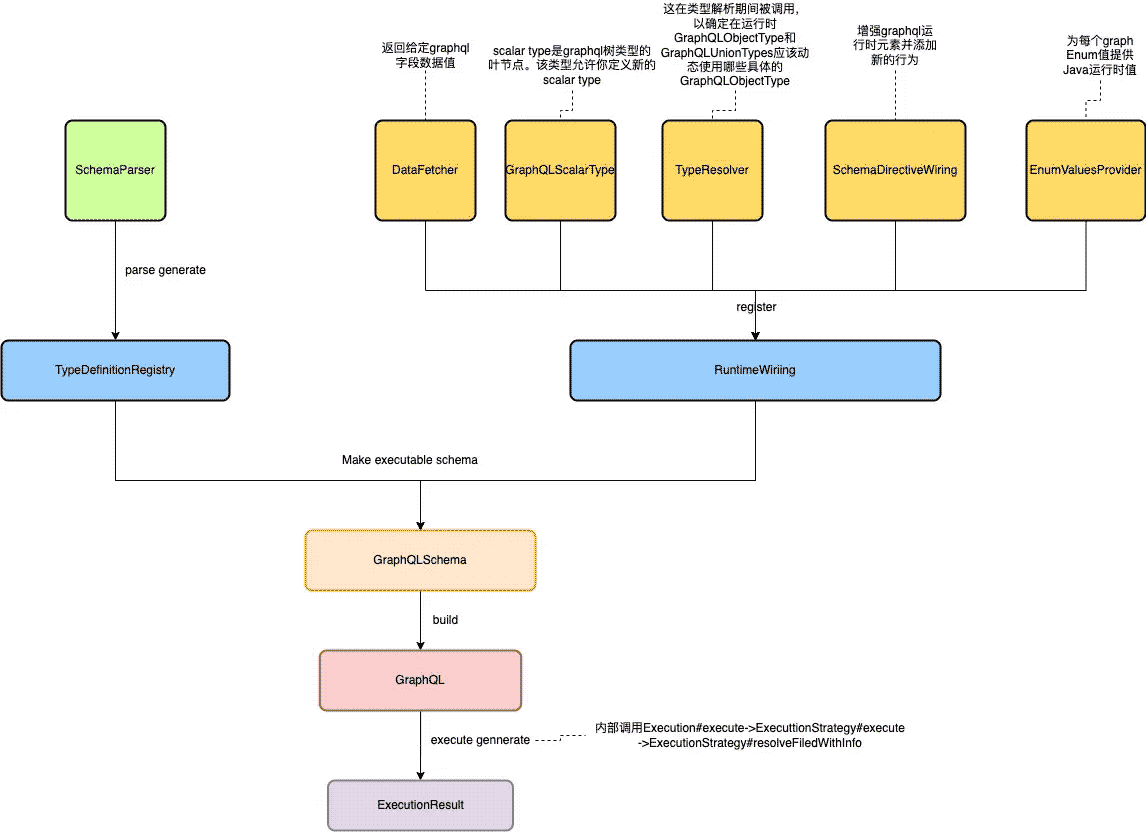
感谢各位的阅读,以上就是“GraphQL背后处理及执行过程是什么”的内容了,经过本文的学习后,相信大家对GraphQL背后处理及执行过程是什么这一问题有了更深刻的体会,具体使用情况还需要大家实践验证。这里是亿速云,小编将为大家推送更多相关知识点的文章,欢迎关注!
边栏推荐
- 114. How to find the cause of Fiori Launchpad routing error by single-step debugging
- 轻量级网络整理及其在Yolov5上的实现
- typescript51 - basic use of generics
- typescript54-泛型约束
- Tanabata festival coming, VR panoramic look god assists for you
- 114. 如何通过单步调试的方式找到引起 Fiori Launchpad 路由错误的原因
- 机器学习——库
- typescript54 - generic constraints
- 带你造轮子,自定义一个随意拖拽可吸边的悬浮View组件
- typescript50-交叉类型和接口之间的类型说明
猜你喜欢
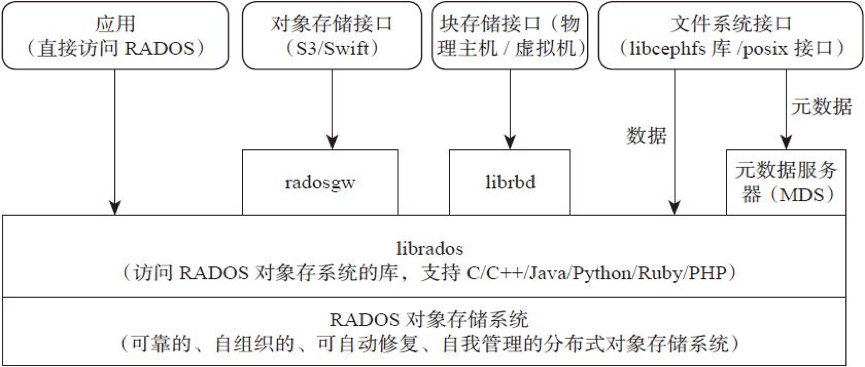
一文参透分布式存储系统Ceph的架构设计、集群搭建(手把手)
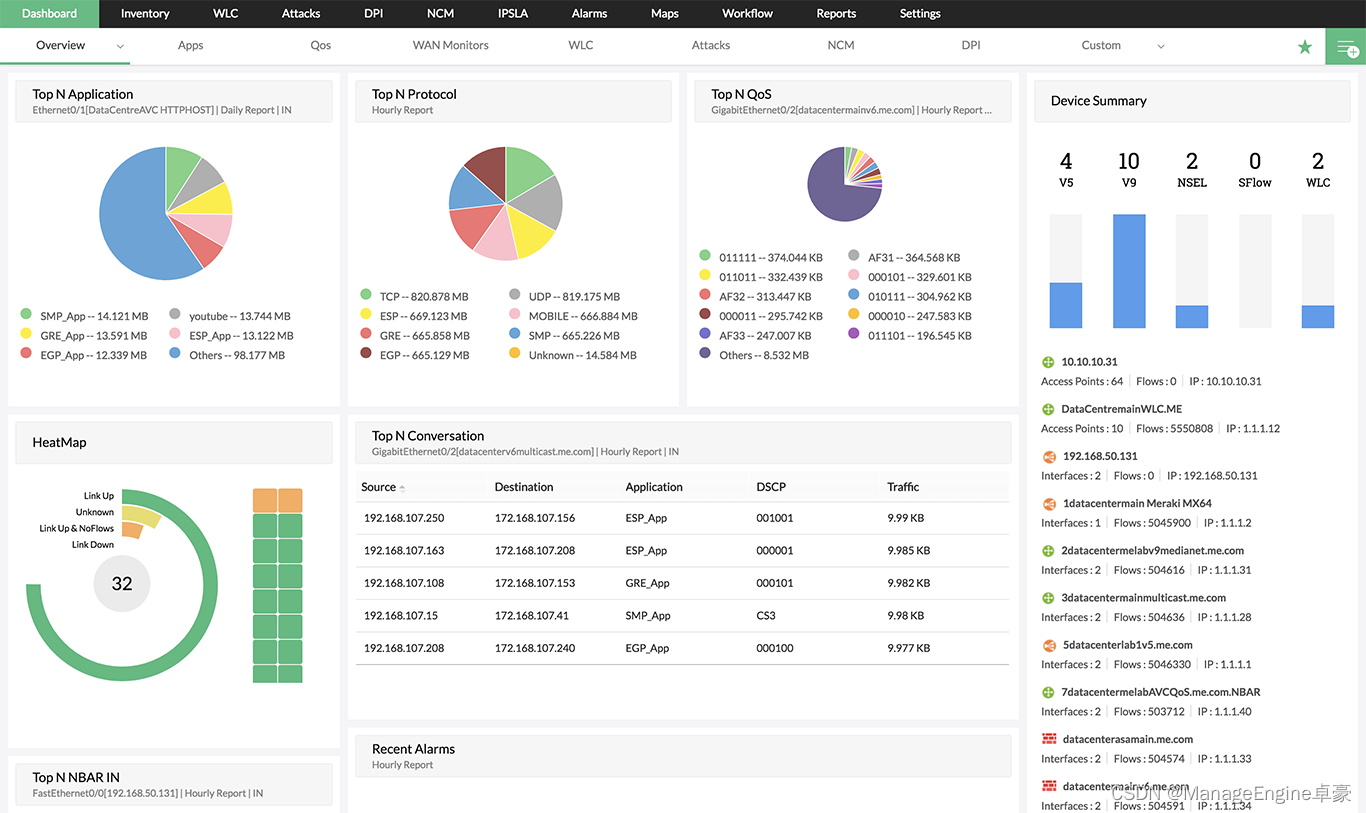
网络带宽监控,带宽监控工具哪个好

GeoAO:一种快速的环境光遮蔽方案
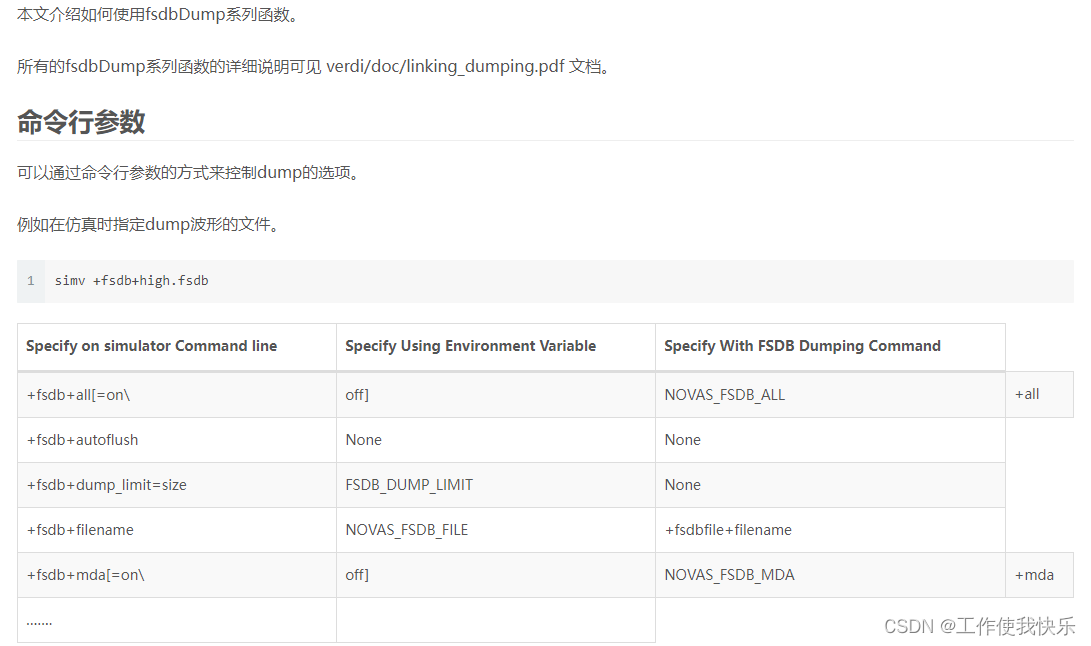
fsdbDump用法
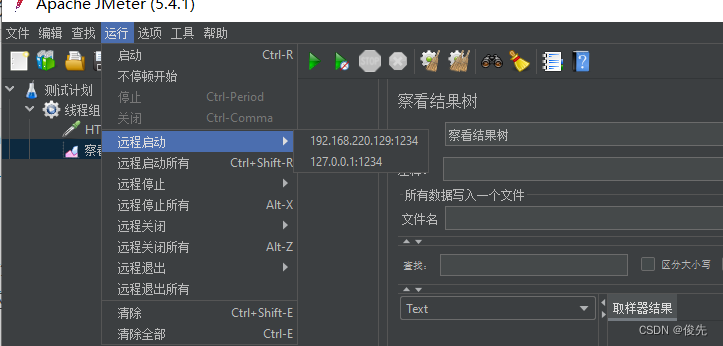
jmeter distributed stress test
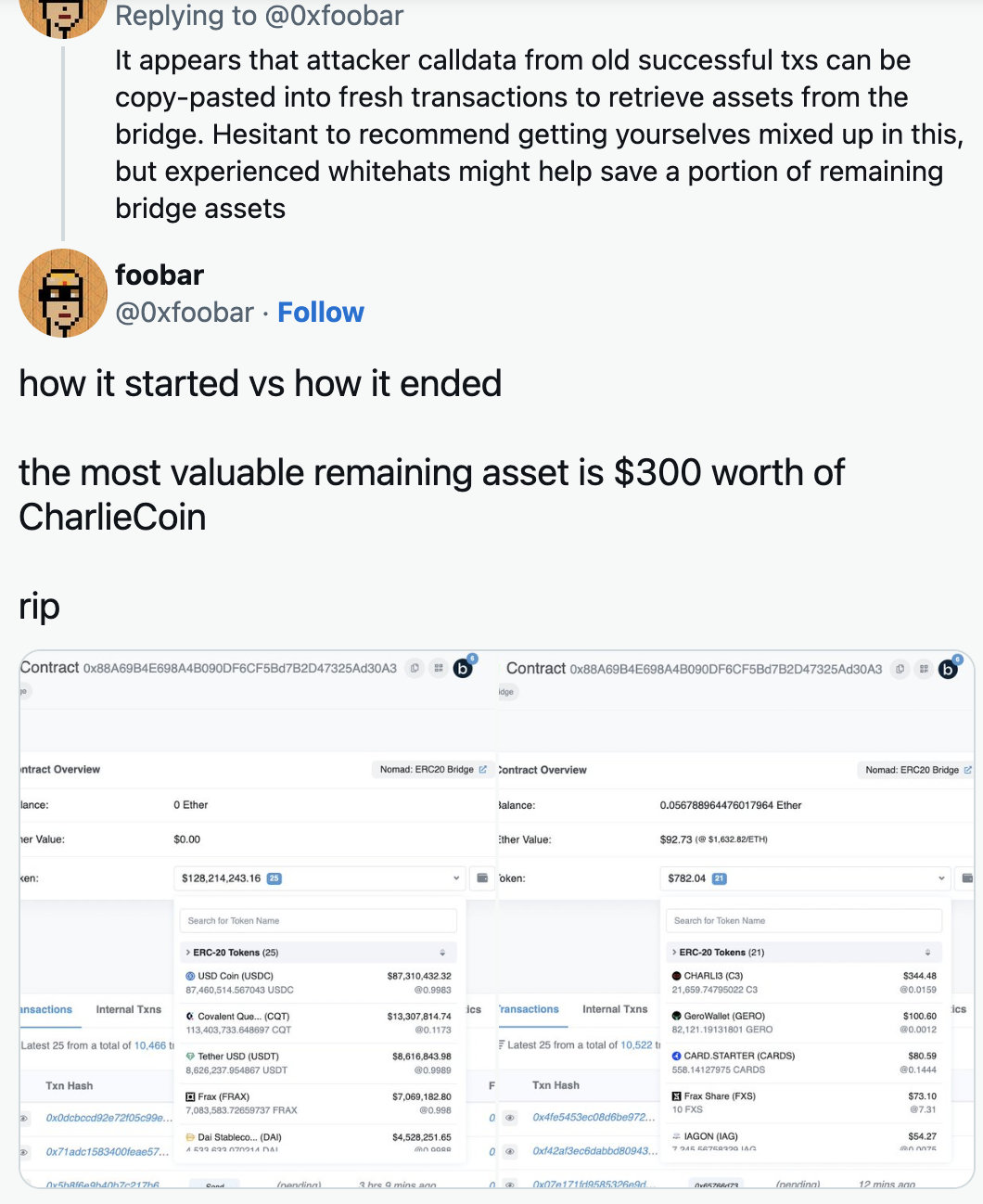
分析:Nomad Bridge黑客攻击的独特之处

Apple told Qualcomm: I bought a new campus for $445 million and may plan to speed up self-development of baseband chips

面试必问的HashCode技术内幕

Analysis: What makes the Nomad Bridge hack unique
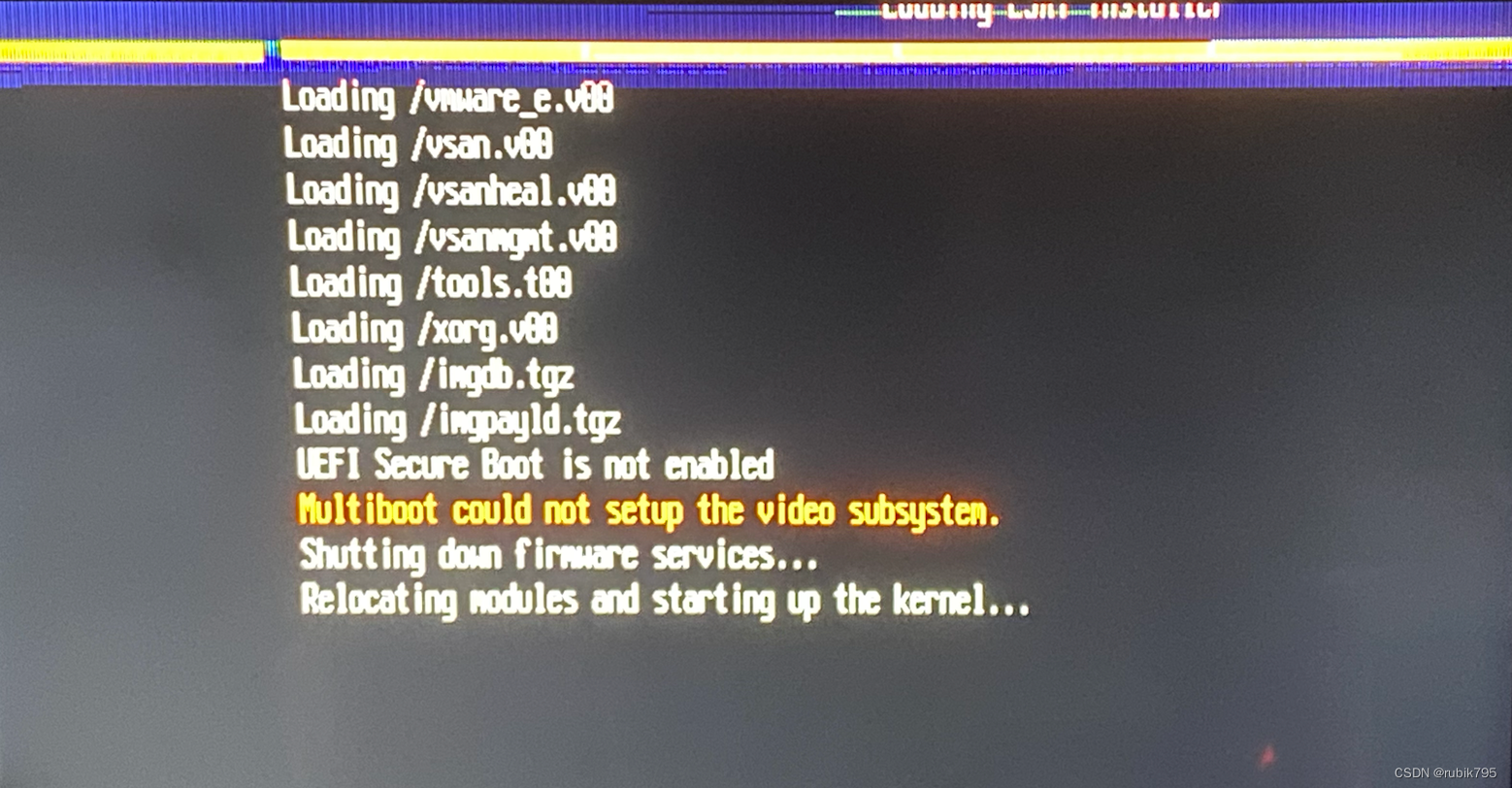
【虚拟户生态平台】虚拟化平台安装时遇到的坑
随机推荐
ASP.NET 获取数据库的数据并写入到excel表格中
ML18-自然语言处理
分析:Nomad Bridge黑客攻击的独特之处
A Preliminary Study of RSS Subscription to WeChat Official Account-feed43
数据库扩容也可以如此丝滑,MySQL千亿级数据生产环境扩容实战
LeetCode 19:删除链表的倒数第 N 个结点
面试必问的HashCode技术内幕
无代码7月热讯 | 微软首推数字联络中心平台;全球黑客马拉松...
Using matlab to solve the linear optimization problem based on matlab dynamic model of learning notes _11 】 【
C# WPF设备监控软件(经典)-下篇
jmeter跨平台运行csv等文件
虚拟机CentOS7中无图形界面安装Oracle
【超详细】手把手教你搭建MongoDB集群搭建
Nanoprobes Alexa Fluor 488 FluoroNanogold 偶联物
outputBufferIndex = mDecode.dequeueOutputBuffer(bufferInfo, 0) 一直返回为-1
pcl点云数据 转化为 Eigen::Map
易动纷享--测试实习生视频面试
扩展卡尔曼滤波EKF
跨域问题解决方式 代理服务器
LYVE1抗体丨Relia Tech LYVE1抗体解决方案